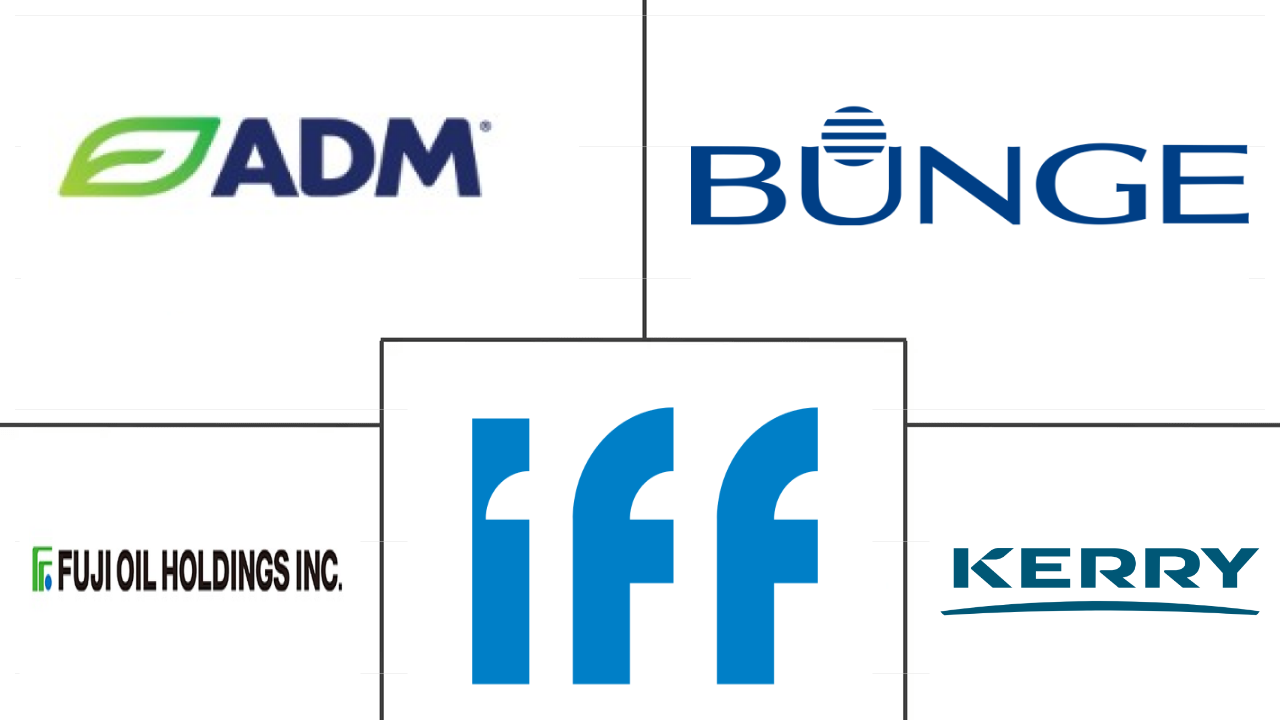Market Size of asia-pacific soy protein Industry
|
|
Study Period | 2017 - 2029 |
|
|
Market Size (2024) | USD 2.59 Billion |
|
|
Market Size (2029) | USD 3.46 Billion |
|
|
Largest Share by End User | Animal Feed |
|
|
CAGR (2024 - 2029) | 6.00 % |
|
|
Largest Share by Country | China |
Major Players |
||

|
||
|
*Disclaimer: Major Players sorted in no particular order |
Asia-Pacific Soy Protein Market Analysis
The Asia-Pacific Soy Protein Market size is estimated at 2.59 billion USD in 2024, and is expected to reach 3.46 billion USD by 2029, growing at a CAGR of 6.00% during the forecast period (2024-2029).
2.59 Billion
Market Size in 2024 (USD)
3.46 Billion
Market Size in 2029 (USD)
5.26 %
CAGR (2017-2023)
6.00 %
CAGR (2024-2029)
Largest Market by Form
49.38 %
value share, Concentrates, 2023
High protein digestibility and optimal nutritional value make SPC an ideal protein source for animal feed. SPC is cheaper than isolates, thereby driving its usage.
Largest Market by End User
53.31 %
value share, Animal Feed, 2023
Soy proteins are widely used in the animal feed sector in the country, owing to their distinct benefits, such as protein digestibility and apt amino acid profile.
Fastest Growing Market by Form
6.95 %
Projected CAGR, Textured/Hydrolyzed, 2024-2029
Hydrolyzed soy proteins have major applications in the animal feed industry, followed by F&B. Constant research in the segment is projected to boost the segment.
Fastest Growing Market by End User
6.62 %
Projected CAGR, Animal Feed, 2024-2029
Soy proteins are widely gaining application in the animal feed sector, including feed for fish, pets, and poultry, mainly as alternatives to the meat or dairy ingredients.
Leading Market Player
10.28 %
market share, International Flavors & Fragrances, Inc., Inc.

International Flavors & Fragrances Inc. is constantly developing new soy proteins with differentiated product portfolios, which is the most important factor in the company's success.
F&B and animal feed together major share in usage of soy protein due to high nutritional properties associated with soy protein
- Asia-Pacific has an established market for soy protein, as it is one of the most accepted traditional foods by consumers in the region. Soy protein has increased functionalities in different foods as a protein ingredient and flavor enhancer, which majorly drives its applications in various end-user segments. Soy protein is predominantly used in the animal feed sector, followed by the food and beverage sector.
- In animal feed, soy protein is primarily used as a dairy substitute and fishmeal for its functionalities, including high protein digestibility, cheaper price point, low anti-nutritional content, and longer shelf life. Accordingly, the animal feed segment is projected to register the fastest CAGR of 6.23% during the forecast period. Soy protein is also extensively used in pet food because of its easy digestibility. Many dogs need to follow a hypoallergenic diet because of allergies to chicken, beef, and other animal protein sources. Soy is a common pet food, and it can help alleviate symptoms. Soy is a protein-rich meat substitute because it is also high in dietary fiber, vitamins, and minerals. Half a cup of cooked textured soy protein has 11 grams of protein.
- In the F&B segment, soy protein is mainly used in meat and dairy alternative products. The meat and meat alternatives and dairy and dairy alternatives sub-segments accounted for 46.24% and 36.72% volume shares of the F&B segment, respectively. With high levels of protein and other nutrients, soybeans are a powerful legume that can easily replace meat and is the main driver for the application segment, along with easy-digestibility and meat-like texture. Soy-fortified milk also observed high demand because of comparable protein, calcium, vitamins A and D, and B vitamins content to cow's milk.
China accounted holds significant share in consumption of soy protein due to high production capacity
- China is the largest consumer of soy protein in the region, attributed to high production capacity that reduces the ingredient's price and boosts its consumption volume. About 70% of the world’s supply of soy protein isolate, a primary ingredient in many plant-based foods, is processed in the Shandong Province in China. It also enables innovations across plant-based products, attracting more consumers to try differentiated product offerings. Soy protein also serves as an alternative to animal-derived meals and provides numerous functionalities, like high digestibility and low levels of anti-nutritional factors.
- Due to constant product developments and consumers' growing demand for vegan food, China is predicted to record the fastest CAGR volume of 8.11% during the forecast period. Around 200 alternative plant-based ingredients are used across soy protein startups in India. India's soy protein market was driven by the high demand from the food and beverage and animal feed sectors, which recorded volume shares of 56.68% and 43.09%, respectively, in 2022. With government bodies and food authorities, such as FSSAI, promoting the consumption of soy protein, its demand is expected to increase further.
- Indonesia holds a significant market share in the soy market, which is projected to register a CAGR value of 2.22% during the forecast period. The government has been working hard to increase soybean production in order to achieve self-sufficiency through programs like Gema Palagung, Bangkit Kedelai, and Farmer’s School for Integrated Crop Management/FSICM for soybean due to the rising demand for protein-rich products. Consumers' interest in soy protein sources has grown significantly due to wellness trends and awareness about nutrition in daily diets.
Asia-Pacific Soy Protein Industry Segmentation
Concentrates, Isolates, Textured/Hydrolyzed are covered as segments by Form. Animal Feed, Food and Beverages, Personal Care and Cosmetics, Supplements are covered as segments by End User. Australia, China, India, Indonesia, Japan, Malaysia, New Zealand, South Korea, Thailand, Vietnam are covered as segments by Country.
- Asia-Pacific has an established market for soy protein, as it is one of the most accepted traditional foods by consumers in the region. Soy protein has increased functionalities in different foods as a protein ingredient and flavor enhancer, which majorly drives its applications in various end-user segments. Soy protein is predominantly used in the animal feed sector, followed by the food and beverage sector.
- In animal feed, soy protein is primarily used as a dairy substitute and fishmeal for its functionalities, including high protein digestibility, cheaper price point, low anti-nutritional content, and longer shelf life. Accordingly, the animal feed segment is projected to register the fastest CAGR of 6.23% during the forecast period. Soy protein is also extensively used in pet food because of its easy digestibility. Many dogs need to follow a hypoallergenic diet because of allergies to chicken, beef, and other animal protein sources. Soy is a common pet food, and it can help alleviate symptoms. Soy is a protein-rich meat substitute because it is also high in dietary fiber, vitamins, and minerals. Half a cup of cooked textured soy protein has 11 grams of protein.
- In the F&B segment, soy protein is mainly used in meat and dairy alternative products. The meat and meat alternatives and dairy and dairy alternatives sub-segments accounted for 46.24% and 36.72% volume shares of the F&B segment, respectively. With high levels of protein and other nutrients, soybeans are a powerful legume that can easily replace meat and is the main driver for the application segment, along with easy-digestibility and meat-like texture. Soy-fortified milk also observed high demand because of comparable protein, calcium, vitamins A and D, and B vitamins content to cow's milk.
| Form | |
| Concentrates | |
| Isolates | |
| Textured/Hydrolyzed |
| End User | ||||||||||||
| Animal Feed | ||||||||||||
| ||||||||||||
| Personal Care and Cosmetics | ||||||||||||
|
| Country | |
| Australia | |
| China | |
| India | |
| Indonesia | |
| Japan | |
| Malaysia | |
| New Zealand | |
| South Korea | |
| Thailand | |
| Vietnam | |
| Rest of Asia-Pacific |
Asia-Pacific Soy Protein Market Size Summary
The Asia-Pacific soy protein market is well-established, driven by its acceptance as a traditional food and its versatile applications in various sectors. Soy protein's functionality as a protein ingredient and flavor enhancer propels its use, particularly in the animal feed and food and beverage sectors. In animal feed, it serves as a cost-effective substitute for dairy and fishmeal, offering benefits like high protein digestibility and longer shelf life. The food and beverage sector utilizes soy protein extensively in meat and dairy alternative products, capitalizing on its high nutritional value and meat-like texture. The region's growing interest in plant-based diets and allergen-free options further fuels the demand for soy protein, making it a key player in the market.
China stands out as the largest consumer of soy protein in the region, benefiting from its high production capacity and innovation in plant-based products. The country's significant processing of soy protein isolate supports its widespread use in plant-based foods. India and Indonesia also contribute to the market's growth, with India seeing increased demand from the food and beverage and animal feed sectors, and Indonesia focusing on self-sufficiency in soybean production. The market is characterized by a fragmented landscape with major players like Archer Daniels Midland Company, Bunge Limited, and Fuji Oil Group. These companies are actively expanding their product offerings and production capabilities to meet the rising demand for soy protein in the Asia-Pacific region.
Asia-Pacific Soy Protein Market Size - Table of Contents
-
1. MARKET SEGMENTATION (includes market size in Value in USD and Volume, Forecasts up to 2029 and analysis of growth prospects)
-
1.1 Form
-
1.1.1 Concentrates
-
1.1.2 Isolates
-
1.1.3 Textured/Hydrolyzed
-
-
1.2 End User
-
1.2.1 Animal Feed
-
1.2.2 Food and Beverages
-
1.2.2.1 By Sub End User
-
1.2.2.1.1 Bakery
-
1.2.2.1.2 Beverages
-
1.2.2.1.3 Breakfast Cereals
-
1.2.2.1.4 Condiments/Sauces
-
1.2.2.1.5 Dairy and Dairy Alternative Products
-
1.2.2.1.6 Meat/Poultry/Seafood and Meat Alternative Products
-
1.2.2.1.7 RTE/RTC Food Products
-
1.2.2.1.8 Snacks
-
-
-
1.2.3 Personal Care and Cosmetics
-
1.2.4 Supplements
-
1.2.4.1 By Sub End User
-
1.2.4.1.1 Baby Food and Infant Formula
-
1.2.4.1.2 Elderly Nutrition and Medical Nutrition
-
1.2.4.1.3 Sport/Performance Nutrition
-
-
-
-
1.3 Country
-
1.3.1 Australia
-
1.3.2 China
-
1.3.3 India
-
1.3.4 Indonesia
-
1.3.5 Japan
-
1.3.6 Malaysia
-
1.3.7 New Zealand
-
1.3.8 South Korea
-
1.3.9 Thailand
-
1.3.10 Vietnam
-
1.3.11 Rest of Asia-Pacific
-
-
Asia-Pacific Soy Protein Market Size FAQs
How big is the Asia-Pacific Soy Protein Market?
The Asia-Pacific Soy Protein Market size is expected to reach USD 2.59 billion in 2024 and grow at a CAGR of 6.00% to reach USD 3.46 billion by 2029.
What is the current Asia-Pacific Soy Protein Market size?
In 2024, the Asia-Pacific Soy Protein Market size is expected to reach USD 2.59 billion.

